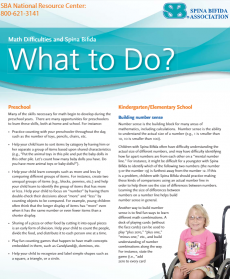Many skills necessary for math begin to develop at a young age.
Preschool
Many of the skills necessary for math begin to develop during the preschool years. There are many opportunities for preschoolers to learn these skills, both at home and at school. For instance:
• Practice counting with your preschooler throughout the day, such as the number of toys, pencils, chairs, etc.
• Help your child learn to sort items by category by having him or her separate a group of items based on shared characteristics (e.g., “Put the animal toys in this pile and put the baby dolls in this other pile. Let’s count how many baby dolls you have. Do you have more animal toys or baby dolls?”).
• Help your child learn concepts such as more and less by comparing different groups of items. For instance, create two unequal groups of items (e.g., blocks, pennies, etc.) and help your child learn to identify the group of items that has more or less.
- Help your child to focus on “number” by having them double-check their decisions about “more” and “less” by counting objects to be compared. For example, young children often think that the longer display of items has “more” even when it has the same number or even fewer items than a shorter display.
• Sharing of a pizza or other food by cutting it into equal pieces is an early form of division. Help your child to count the people, divide the food, and distribute it to each person one at a time.
• Play fun counting games that happen to have math concepts embedded in them, such as Candyland®, dominos, etc.
• Help your child to recognize and label simple shapes such as a square, a triangle, or a circle.
Kindergarten/Elementary School
Building number sense
Number sense is the building block for many areas of mathematics, including calculations. Number sense is the ability to understand the actual size of a number (e.g., one is smaller than
10, 10 is smaller than 100).
Children with Spina Bifida often have difficulty understanding the actual size of different numbers, and may have difficulty identifying how far apart numbers are from each other on a “mental number line.” For instance, it might be difficult for a youngster with Spina Bifida to identify which of the following two numbers (the number 9 or the number 19) is furthest away from the number 12. If this is a problem, children with Spina Bi a should practice making these kinds of comparisons using an actual number line to help them see the size of differences between numbers. Learning the size of differences between numbers on a number line helps build number sense in general.
Another way to build number sense is to and fun ways to learn different math combinations. A deck of playing cards (without the face cards) can be used to play “plus zero,” “plus one,”
“minus one,” etc., and build an understanding of number combinations along the way. For instance, state the game (i.e., “add zero to every card I show you”), and then quickly go through the deck, allowing the child to add zero to each number shown. This helps the child begin to memorize the idea of “adding on,” or “subtracting from,” and begins to make it more automatic.
Problems with number sense can also result in children with items and judging which group has more simply by looking at them. Children with Spina Bifida can improve their number sense by practicing comparisons, and quickly determining which group has the most items simply by “how big it looks.” Children can then count the dots to check the accuracy of their answers (while also practicing adding skills).
While classroom accommodations such as calculators can be helpful, many youths with Spina Bifida require special intervention to address their learning disability. Problems with number sense can be identified as early as age 5 and 6.
Understanding math procedures
Math calculation includes many different procedures, and understanding of math procedures and children with Spina Bifida often have difficulty learning these procedures (e.g., borrowing, carrying, long division). Even when youth with Spina Bifida learn these math procedures, many have difficulty remembering to use them consistently.
Early and periodic screening of math skills is recommended for students with Spina Bifida. Early problems acquiring math procedures can be identified by 2nd or 3rd grade. However, as new math procedures continue to be learned as students advance in grade, close monitoring of math progress is recommended.
Tags



